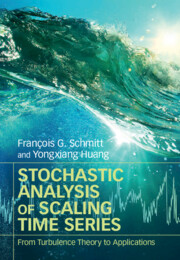Book contents
- Frontmatter
- Contents
- List of figures
- Preface
- 1 Introduction: a multiscale and turbulent-like world
- 2 Homogeneous turbulence and intermittency
- 3 Scaling and intermittent stochastic processes
- 4 New methodologies to deal with nonlinear and scaling time series
- 5 Applications: case studies in turbulence
- 6 Applications: case studies in ocean and atmospheric sciences
- References
- Index
2 - Homogeneous turbulence and intermittency
Published online by Cambridge University Press: 05 December 2015
- Frontmatter
- Contents
- List of figures
- Preface
- 1 Introduction: a multiscale and turbulent-like world
- 2 Homogeneous turbulence and intermittency
- 3 Scaling and intermittent stochastic processes
- 4 New methodologies to deal with nonlinear and scaling time series
- 5 Applications: case studies in turbulence
- 6 Applications: case studies in ocean and atmospheric sciences
- References
- Index
Summary
Introduction
In this book, we will consider stochastic time series with scaling properties and how to analyze them. The general inspiration, and the theoretical foundation of our approach, is the field of fully developed turbulence. Many properties of fields and time series, and many concepts, have been found and developed in the field of turbulence, and later exported to other complex fields such as engineering and natural sciences. Hence in this introduction chapter, we have revised some basic concepts and results in the field of locally homogeneous and isotropic three-dimensional turbulence. Older, more general references in this respect are the following: Batchelor (1953); Monin and Yaglom (1971); Tennekes and Lumley (1972); Frisch (1995); Pope (2000). With our consideration of time series, turbulence is first presented as a 3D problem, from which time series are extracted, and which inherit mainly nonlinear properties from the 3D world.
Turbulence is a phenomenon that is still only partly understood. However it concerns directly or indirectly a large number of scientific fields: meteorology, oceanography, astronomy, hydraulics, aeronautics, environment, chemical industry, automotive engineering, renewable energy, etc. A better understanding and theoretical description of turbulence is badly needed for practical applications in all these fields.
The first use of “turbulence” for sinuous motions in fluid mechanics was apparently due to Lord Kelvin in a paper published in 1887 (Thomson, 1887; Schmitt, 2007a). There are several definitions of turbulence. A generalist definition would indicate “instability or irregular movements in a fluid.” In physics the definition uses the dimensionless Reynolds number Re = UL/ν, where U is a typical velocity scale, L a typical length scale, and ν the kinematic viscosity of the fluid. When Re is small, the flow is laminar, and the fluid motion is regular. There is a transition value where instabilities occur, and when Re is very large. Here the flow is said to be in a state of fully developed turbulence. Such flow is also chaotic due to the nonlinear nature of Navier-Stokes equations. Another characteristic of turbulence is its very efficient mixing property. Tennekes and Lumley (1972) insisted on the three dimensional nature of turbulence, and also on the fact that it is a dissipative system, needing, to be in a stationary state, a continuous input of energy.
Information
- Type
- Chapter
- Information
- Stochastic Analysis of Scaling Time SeriesFrom Turbulence Theory to Applications, pp. 12 - 40Publisher: Cambridge University PressPrint publication year: 2016
